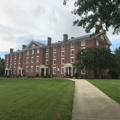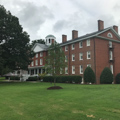One of the most venerable-looking collegiate landscapes in the rural South, Hampden-Sydney College was established by Presbyterians in 1776. Its Scots-Irish founders named it for John Hampden and Algernon Sydney, two seventeenth-century advocates of civil and religious freedom. Union Theological Seminary, a Presbyterian institute associated with the college, faced the campus from an adjoining hillside until the seminary moved to Richmond in 1898. The earliest surviving of the remarkable group of early-nineteenth-century buildings from Hampden-Sydney and the seminary are Cushing and Venable halls (primarily dormitories), five smaller edifices that began as houses, and a chapel designed by Robert L. Dabney. They have been joined by several later buildings, many of them Colonial Revival. Two principal streets cut through the green hillsides of the twelve-hundred-acre campus—College Road, running north to south, and Via Sacra, running west to east.
You are here
Hampden-Sydney College
If SAH Archipedia has been useful to you, please consider supporting it.
SAH Archipedia tells the story of the United States through its buildings, landscapes, and cities. This freely available resource empowers the public with authoritative knowledge that deepens their understanding and appreciation of the built environment. But the Society of Architectural Historians, which created SAH Archipedia with University of Virginia Press, needs your support to maintain the high-caliber research, writing, photography, cartography, editing, design, and programming that make SAH Archipedia a trusted online resource available to all who value the history of place, heritage tourism, and learning.





